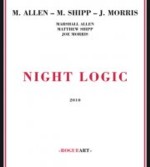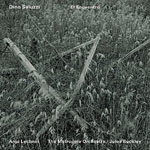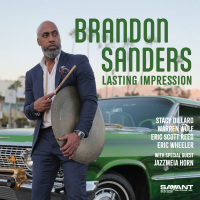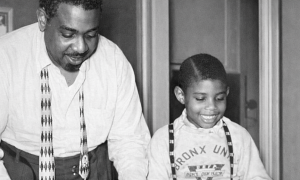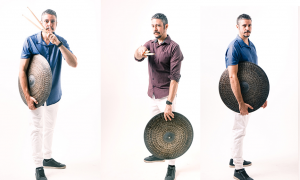Home » Jazz Articles » Interview » Giacomo Gates: An Unconventional Backstory
Giacomo Gates: An Unconventional Backstory
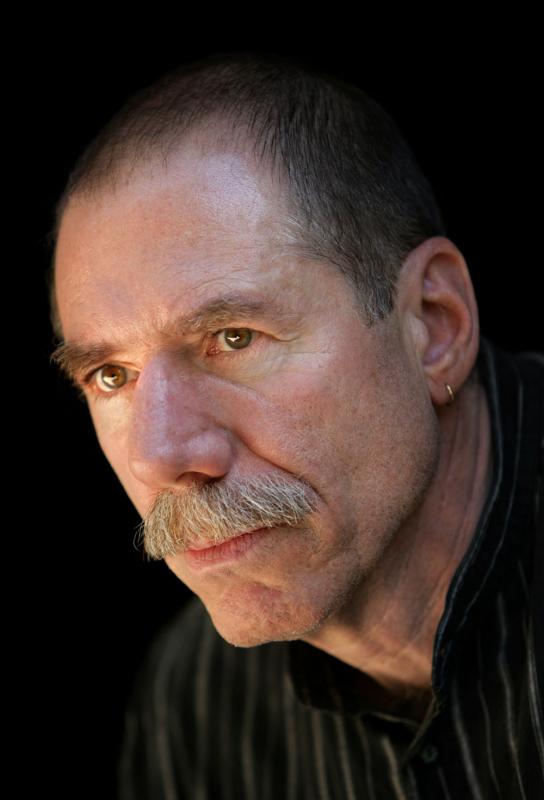 Giacomo Gates brings a rich, full-bodied timbre to the vocal jazz table. His pure vocalese approach has earned him lauds among critics, who hail him a champion artist in the modern jazz genre. He's been performing alongside the most recognized artists in the industry, using only his voice to produce a broad range of spectral color. Gates can be found singing melodies, lyrics, and even singing bass lines or flute solos.
Giacomo Gates brings a rich, full-bodied timbre to the vocal jazz table. His pure vocalese approach has earned him lauds among critics, who hail him a champion artist in the modern jazz genre. He's been performing alongside the most recognized artists in the industry, using only his voice to produce a broad range of spectral color. Gates can be found singing melodies, lyrics, and even singing bass lines or flute solos.The vocalese medium has been expanding since Eddie Jefferson first began barking out bebop solos in the early 1960s. Jefferson's hard swing phrasing opened up a score of possibilities for the archetypical jazz singer. Since then, the vocalese genre has been nurtured into a creatively unique branch on jazz's straight-ahead tree. Gates continues to carry this vocal tradition into today's modern realm with continence.
All About Jazz: When did you start singing, and what were the events that started your career in motion?
Giacomo Gates: The first time I sang in public, I was six years old. I was taking tap dancing lessons and when recital time came, I didn't want to dance. The dance teacher told me, "If you don't dance, you'll have to sing instead." "Solid," I thought to myself. So I at performance time, I sang the song "Pretty Baby," while eight boys and girls tapped behind me.
I also began guitar lessons at age eight, and continued lessons until the age of seventeen. I worked for a short time playing weddings, which at that time, was all about playing the Great American Songbook. I was turned on to very good music at a young age.
AAJ: Your back story isn't an altogether conventional one. What was life like before the music?
GG: Music for me was fun and challenging. I wasn't trying to make a living at it in the beginning, nor was I encouraged or discouraged by anyone. When I got out of high school, I tried college for a year. I went to school for Mechanical Engineering, but not having a very strong background in math, and having to work to support myself during college, it wasn't the best choice for me. I was more interested in the hands-on part of building things.
I left school and began working as a laborer on a road crew. Soon, I was driving dumps and tri-axles, and later tractor trailers. It wasn't long before I learned how to run heavy equipment like loaders, dozers, scrapers and graders. After several years of working in Connecticut, I heard about the Alaskan Pipeline and moved to Alaska, with the intention of working a year. That year turned into fourteen years. I worked in Washington State and Arizona for a couple of years in between as well.
While living in Fairbanks, I got involved with a summer arts festival and took a vocal workshop. There I was encouraged by several instructors and a guest artist to pursue my own singing. I also was beginning to feel like it was time for a change, so I returned to Connecticut, because I knew the surrounding cities had a music scene. Areas like New York City, Washington DC, Philadelphia, Boston, and New Haven, Hartford.
AAJ: Your earliest influences, within the jazz realm. What was your first exposure to the genre like?
GG: The first jazz LP I bought was [Dave Brubeck's Time Out (Columbia, 1959). I was around ten years old. I was intrigued by the different time signatures.
The second LP I owned was a Monk record. He played in four. I found his melodies and percussive accents very interesting, and humorous. After that, Dexter Gordon, Lester Young Lou Donaldson Dizzy Gillespie,Miles Davis Freddie Hubbard, Charlie Parker, Count Basie, Duke Ellington, and on and on.
AAJ: Your unique vocal style, often times, is very instrument-like in quality. How did you come to develop this sense of harmonic presence? Was it something you developed on your own, or were there guiding influences along the way?
 GG: I had the best teachers, and a record collection that I wore out. Also growing up in Connecticut, I was able to hear the New York City radio stations that played straight-ahead jazz. The stations had radio personalities that talked, and taught the music they played. I listened to instruments, and played my guitar along with the music. The singers that I dug were the most instrumental-like. I heard Perry Como, Bing Crosby, Dean Martin, Frank Sinatra,Sammy Davis Jr. and cats like that. Of course I dug them, but as I got older, I heard Eddie Jefferson, Lambert, Hendricks & Ross, Mose Allison, Joe Williams, Al Hibbler, Babs Gonzales, Cab Calloway, Sarah Vaughan, Betty Carter, Mark Murphy, Anita O'Day, Carmen McRae, Martha Raye, Louis Prima and Keely Smith. The list goes on and on, and even includes James Brown, Al Jarreau, The Four Tops, Wicked Wilson Pickett, Aretha Franklin.
GG: I had the best teachers, and a record collection that I wore out. Also growing up in Connecticut, I was able to hear the New York City radio stations that played straight-ahead jazz. The stations had radio personalities that talked, and taught the music they played. I listened to instruments, and played my guitar along with the music. The singers that I dug were the most instrumental-like. I heard Perry Como, Bing Crosby, Dean Martin, Frank Sinatra,Sammy Davis Jr. and cats like that. Of course I dug them, but as I got older, I heard Eddie Jefferson, Lambert, Hendricks & Ross, Mose Allison, Joe Williams, Al Hibbler, Babs Gonzales, Cab Calloway, Sarah Vaughan, Betty Carter, Mark Murphy, Anita O'Day, Carmen McRae, Martha Raye, Louis Prima and Keely Smith. The list goes on and on, and even includes James Brown, Al Jarreau, The Four Tops, Wicked Wilson Pickett, Aretha Franklin.My sound, or approach, is a combination of all of these singers, as well as many other singers, and instrumentalists that have inhabited my ears for many years. Also, the experience of living life. Of having tasted many different lifestyles. Being in different places, and different situations. Ups and downs. Spending time with myself, trying to digest what goes on in one's head, and how to express a lyric or melody, whether written or learned. Trying to let the song do something to me, rather than me do something to it. No affectations, nothing contrived, no tricks. If it's a good time, it's for real. Likewise, if it's sad and a heart breaker, it's for real.
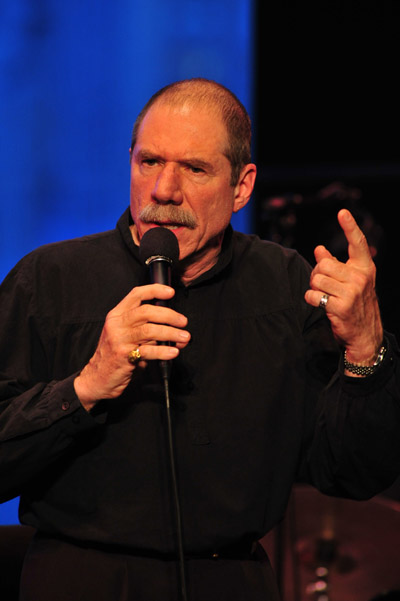 AAJ: New York City. You were there during a very special era for the music. What was the atmosphere like when you were beginning your career? How did the players respond you, as a new vocalese artist in town?
AAJ: New York City. You were there during a very special era for the music. What was the atmosphere like when you were beginning your career? How did the players respond you, as a new vocalese artist in town?GG: I didn't go to the "open mike" nights, I went to the sessions. I found out that some cats knew what time it was, others didn't. I took my lumps, being called up at the end of the last set, or being ignored because I wasn't a good looking woman. I had to deal with some folks who were not considerate of singers. It didn't matter to me, I came out to work on my stuff and get around the scene. Sometimes, I'd walk up to the bandstand like I was one of the horns, and join in on whatever tune the group was playing. In the standard key. At their tempo. Some of the heavy , more experienced musicians were very open to new things, and also very encouraging to me. Musicians like Bill Finegan, Ted Curson, Walter Bishop, Jr. Jr., Max Roach, Lou Donaldson, Richie Cole, Freddie Hubbard, Sheila Jordan, Mark Murphy, Jon Hendricks, Dr. Billy Taylor, Barry Harris, and the lady who produced my first recording, Helen Keane.
AAJ: And how has the jazz realm changed since the beginning of your career? What is the atmosphere like now, as opposed to the era when you were assuming your career?
GG: Let me just say that it's very different.
AAJ: Did Eddie Jefferson's career have an impact on you? And what was it that led you to being a part of the album, Remembering Eddie Jefferson (Berghem, 2002), a truly impressive work that preserves an art that Jefferson pioneered.
GG: Eddie Jefferson's music and his lyrics were fun, interesting, sad, soulful, musical. He was actually "in the band," as a real jazz singer. Shortly after moving back to Connecticut, Richie Cole was playing at a club in the town I was living in. I went to catch him. I met him, and ended up doing a few dates with Richie shortly after that. Working a few dates with Richie really helped me get closer to the music.
Remembering Eddie Jefferson was not my recording, although I was gassed to get the call to be on it. Eddie Landsberg was the leader on the record, and played B-3. I was originally asked to sing four tunes on the recording. After completing them, the co-producer and drummer, Ben Dixon, said, "Might as well let the 'mickey fickey' sing."
I ended up sing ten tunes out of twelve, and the session was big fun. All of us in one room, all live recordings. There was great energy from everyone, and the record became a kind of cult hit. Too bad the company only did one printing.
AAJ: You seem to be continually forging ahead with new concepts, and new album projects. Is there a particular album project that really stands out, in your own personal history, as a truly special work?
GG: I'm happy with all my recordings, as they were my best effort at that particular time.
Blue Skie (1995), on DMP, and Fly Rite (1998), on Sharp Nine, were good records. The radio liked them, and both records got very good ink. Centerpiece (2004), on Origin Records, also did well with radio play, and the critics dug it too. The music was very accessible and recognizable. Luminosity (2008), on G88 Music, stretched things a bit more, the tunes were still mostly straight-ahead, there were a few different twists on the album. I'm flattered and gassed that they have all received positive ink, and gotten lots of radio airplay. I like finding different a repertoire, putting tunes together, that fit over each other. However, I think my favorite recording will always be the next one.
AAJ: What is it that makes a particular album come alive for you? In other words, what are the elements that you look for, when aiming for a successful collaboration?
 GG: Most of the recorded tunes are music that I sing at a performance, so they're very lived in. Only a few tunes were recorded specifically for a record. Repertoire is important to me.
GG: Most of the recorded tunes are music that I sing at a performance, so they're very lived in. Only a few tunes were recorded specifically for a record. Repertoire is important to me.I like a mix. Familiar music, esoteric, humorous, blues, ballads, an original song, or a new tune that fits over the well-known chord changes of a familiar tune. It all adds up to being inherently thematic. The musicians are also very important. Interaction, energy, and being in the moment. Of course a good engineer and good studio are also essential. All of it needs to come together in a natural rhythm. It's got to feel good, in order for it to happen correctly.
AAJ: Are there any upcoming projects that we can expect to look forward to? Any collaborations that you'd care to share?
GG: I'm involved with a live recording of a big band. The New England Jazz Ensemble. It's their session, but I'll be singing three tunes. Two other artists from New England, Ali Reyerson and John Abercrombie will also be playing three tunes each. It should be a lot of fun, as it's an excellent band, and the recording will be live, with an audience.
There are a few travel dates coming up and some things that I'm still working on. I've got a couple of recording ideas cooking, though not at liberty to say what they are, or when they're taking place. It's always an adventure.
Selected Discography
Giacomo Gates, Luminosity (AAO, 2008)
Ted Howe, Love Songs (Summit, 2007)
Giacomo Gates, Centerpiece (Origin, 2004)
Eddie Landsberg, Remembering Eddie Jefferson (Berghem, 2002)>
Giacomo Gates, Fly Rite (Sharp Nine, 1998)
Giacomo Gates, Blue Skies (DMP, 1995)
Photo Credits
Page 1: John Abbott, Courtesy of Giacomo Gates
Page 2: Frank Stewart, Courtesy of Giacomo Gates
Tags
Giacomo Gates
Interview
Sean Dietrich
United States
Eddie Jefferson
Dave] Brubeck
Dexter [Gordon]
Lester Young,
Lou Donaldson,
Dizzy Gillespie
Miles Davis,
Freddie Hubbard
Charlie Parker
Count Basie
Duke [Ellington]
Bing Crosby
Dean Martin
frank sinatra
Sammy Davis
Lambert, Hendricks & Ross
Mose Allison
Joe Williams
Al Hibbler
Babs Gonzales
Cab Calloway
Sarah Vaughan
Betty Carter
Mark Murphy
Anita O'Day
Carmen McRae
Martha Raye
Louis Prima
Keely Smith
James Brown
Al Jarreau
Aretha [Franklin]
Bill Finegan
Ted Curson
Walter Bishop
Max Roach
Lou Donaldson
Richie Cole
Sheila Jordan
Jon Hendricks
Billy Taylor
Barry Harris
Eddie Landsberg
John Abercrombie
PREVIOUS / NEXT
Giacomo Gates Concerts
Support All About Jazz
 All About Jazz has been a pillar of jazz since 1995, championing it as an art form and, more importantly, supporting the musicians who make it. Our enduring commitment has made "AAJ" one of the most culturally important websites of its kind, read by hundreds of thousands of fans, musicians and industry figures every month.
All About Jazz has been a pillar of jazz since 1995, championing it as an art form and, more importantly, supporting the musicians who make it. Our enduring commitment has made "AAJ" one of the most culturally important websites of its kind, read by hundreds of thousands of fans, musicians and industry figures every month.


